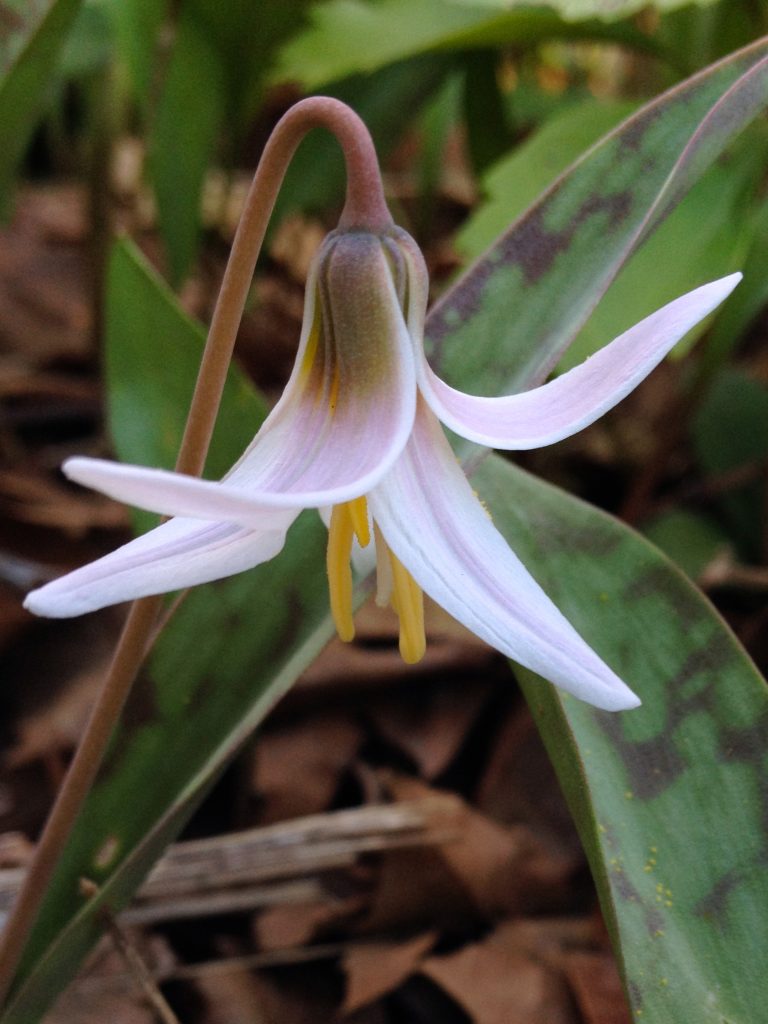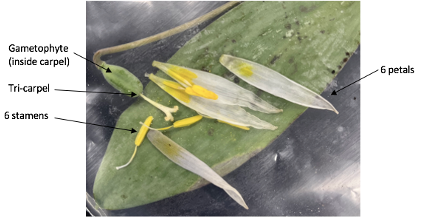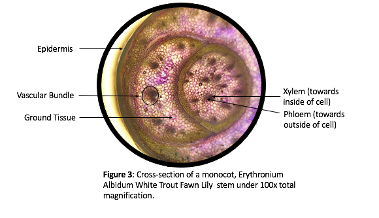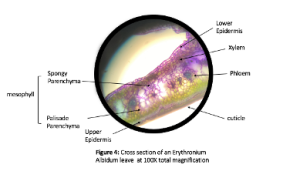1.3 Erythronium Albidum
Jordyn Snell
Erythronium Albidum
Author: Jordyn Snell
1. Plant Description
The Erythronium Albidum is commonly called the White Trout lily, White Dogtooth Violet, White Fawn lily, or Adder’s-Tongue. The Erythronium Albidum is an herbaceous, hermaphrodite, monocot, angiosperm. It’s a perennial known as a spring ephemeral, as it blooms between April and May, depending on the location. After flowering, it lasts for approximately two weeks. Not only does it appear in the Carolinian forest, but it can also be found in multiple places in Eastern North America and in wide strips in Europe and Asia. Its fruit type is a capsule that consists of 3 chambers with two rows of flattened seeds each (White Trout Lily, n.d.).
2. Identification
The Erythronium Albidum has a native distribution from Southern Ontario to Eastern Texas. It is commonly found on deciduous forest floors as they prefer humus-rich, moist to dry, acidic to neutral soil with part to full shade coverage.
They typically grow to approximately 15-30cm tall and 7-15cm wide. Erythronium Albidum develops a pair of thick, simple basal leaves with a single bell-shaped white flower consisting mainly of white or pink-tinged petals. The leaves are typically coloured in brown-green or gray-green mottling or have no mottling at all (White Trout Lily (erythronium albidum), yellow trout lily (erythronium …), 2016).
The Erythronium Albidum has nodding flowers that consist of 6 petals and 6 stamens that are either brown or yellow. A larger flower will show with the yellow stamens, while a smaller flower will present brown stamens. The abaxial of the petal can be light blue/lavender in colour, with yellow spots at the base of the adaxial.
There are approximately twenty recognizable erythronium species, such as the Erythronium Americanum. However, these two can be differentiated by their colouring due to the Americanum being rich yellow. Most species in the Erythronium family are easily distinguishable by the colouring and size of the nodding flower and its stamens (Erythronium, 2020).

3. Cultivation
The Erythronium Albidum is available for cultivation and can be useful for underplanting around large shaded perennials, such as Hostas, Bleeding Hearts and Columbines. Although the Erythronium Albidum can be easily found in their native areas, obtaining them from a reputable nursery is best instead of trying to relocate from the wild. Not only is this due to the fact that removing these plants can disrupt the ecosystem, but many plants, like the Erythronium Albidum tend not to strive outside of natural habitat once moved.
Erythronium Albidum corms should be planted 5-7cm deep and 10-15cm apart in a large location to allow the plant to spread and naturalize. The pointed end of the corms should be planted face down. Once the plant begins to develop, weeding should be done carefully to avoid damaging any offset shoots, as they will form new corms.
The Erythronium albidum prefers partial shade or spots of sunlight in loose humus rush soil that is fairly neutral with an optimal pH range of 6.8-7.2. Shredded leaves and pine straw can be used as mulch for the bulbs overwinter and can be favourable for the plant during growth. Like many species in the Erythronium family, the Albidum needs consistent moisture, especially in times of drought. Any partial shade will allow for more moisture retention in the soil, as well as the addition of natural mulch, such as pine bark. The Erythronium Albidum does not need any fertilizers as long as the soil conditions are optimal for growth. If needed, a layer of compost can be applied during the spring to help growth.
The Erythronium Albidum reproduces and tends to spread well naturally; however, this is easily achieved manually as well. The best time to propagate the Erythronium Albidum is during the fall, using a shovel to dig up the root clumps carefully. From the root clumps, brush away any remaining dirt and separate tiny corms, discarding any that are soft. The corms can be replanted in a new location with similar conditions and techniques as above.
The Erythronium Albidum can be grown from their seed, however, it is a very slow process and can be years before resulting in any flower (Aloi, 2020).
4. Cultural History
The leaves and bulbs of Erythronium Albidum are edible and can be eaten roasted, boiled, or even raw. However, it should only be consumed when lots are present, as removing any of the two leaves can kill the plant. Erythronium Albidum is known to be mildly emetic; therefore, large consumption of these can cause sickness and vomiting.
Medical uses of the plant consist of a compound that can be infused, which was used by the Cherokee to help with fainting. Additionally, the leaves could be crushed and then warmed to result in a juice that was used to pour over unhealed wounds that would not heal themselves. Tea could be made from the roots and could be used to break fevers as well. Not only did the roots provide a medical use but they could be chewed and then spit into the water for fish bait (Mike, 2015).
Another species of Erythronium, the Americanum, was used by Iroquois women as contraception to prevent pregnancy.
5. Life Cycle

Germination
The embryo starts to elongate during September due to rainfall, as the Erythronium Albidum requires a moist, cold period to help it grow. The embryo enlarges to fill the space occupied by the endosperm. This is a slow process during the fall as the embryo only reaches half the size of the seed by December. It’s thought that the rate of growth is related to the amount of moisture in the soil. Around the end of the year, the radicle is forced through the micropyle and into the soil; this is followed by the stem apex being pushed forward by the elongation of the embryo and stays in a related position to the radicle during the elongation of the cotyledon. The lower part of the cotyledon is elongated in a vertical axis, and it reaches 1-3cm down in the soil; once the endosperm is exhausted, downward elongation ceases. The upper end of the cotyledon is now the zone of elongation and is elevated into the air approximately 8-10cm above the soil. The cotyledon will act as the first foliage leaf with photosynthetic properties, this typically takes place during the summer following that fall and will not be functional until another following spring. The stem apex becomes dome-like through a cavity and is then enclosed by the cotyledon at the base of the foliage and forms a bud. Due to the first part of elongation of the cotyledon downwards, the stem apex is typically buried deep. This allows for a corm to be developed by the bud. Two more buds will typically form in addition to the main bud and elongate as runners, which eventually form bulbs. The primary root drops down by gravity around the emergence of the cotyledon. The roots will continue to protrude from the base of the corm in the fall. The developing process will repeat in subsequent seasons in order to fully mature the bulb. The total time between germination and flowering is at least six years.
Mature plants
When the Erythronium Albidum is young, it only consists of one leaf. Their second leaf does not protrude until the plant continues to mature and is beginning to bloom. The leaves on the Erythronium Albidum are simple and rise opposite from each other on the stalk. They take an oblong shape and have a tapered point.
The floral shoot is formed from the stem apex and the corm gets developed from a bud at the base of the shoot. The final structure formed from the stem apex is the flower bud. The production of flowers marks maturity and finishes the cycle of development from seed to seed. Due to the continuance of the original stem apex until flowering, there is a series of immature corms formed from runners. After the plant flowers, the vegetative structures become secondary in importance, resulting in a short life so that a new corm can be developed from an axillary bud at the base of the shoot.
Reproduction and Pollination
The main way the Erythronium Albidum reproduces and spreads is by runners; this is more efficient for the plant due to the long time it takes for the seeds to develop. In most species of Erythroniums, the runner starts from the elongation of the root’s axillary buds’ scales, which forms descending axes. On a horizontal rhizome, a bud will form and stand up vertically at the end of the elongation period of the runner. An additional bulb will form from the terminal bud on the runner and start to produce another flowering plant.
Just like many flowering plants, the Erythronium Albidum has many pollinators. One of the main pollinators for the Erythronium Albidum is both short & long-tongued bees, such as honeybees, mason bees, cuckoo bees, digger bees and more. The long-tongued bees will collect pollen but will also suck the nectar from the base of the flowers. The short-tongued bees and honeybees will only collect the pollen from the flower(White Trout Lily (Erythronium Albidum, n.d.).
Another way the Erythronium Albidum disperses is through a process known as myrmecochory. Ants will carry the seed away from the flowering plant, which can allow for germination to take place somewhere else.
Although this has no relation to reproduction, the Erythronium Albidum’s leaves are occasionally eaten by white-tailed deer. However, any damage caused to the plant is typically minor due to the small size and short life of the foliage.
Seeds
The seeds of the Erythronium Albidum mature as the rest of the plant dies off and their establishment is slow and difficult. They tend to be approximately 2.5 cm in size.
When the ovule becomes fertilized, it enlarges rapidly through the growth of the embryo sac. The endosperm develops slowly, causing it to be a layer of lining for the wall of the sac for a long period of time. The endosperm’s development is slow due to the germination of the embryo during a low vegetative activity. It then develops as a large mass of cells in the micropylar end of the sac, and as the seed reaches full development, the embryo is filled with hard endosperm made of cellulose. It’s thought that the large mass of endosperm is associated with the delayed development of the embryo and the 5-6 years before flowering, which is why those who want to cultivate it use the bulbs/corms (Blodgett, 1910).
6. Anatomy and Physiology

The Erythronium Albidum possesses a bulb or corm. Many will call it either or. As it’s a member of the lily family, many believe it should be called a bulb. However, others say that it’s a corm as it’s a fleshy, swollen base to the stem. (White Trout Lily (erythronium albidum) yellow trout lily (erythronium …), n.d.). Nevertheless, this structure allows for the Erythronium Albidum to reproduce underground by rhizomes and runners that are spread from the main bulb/corm. The terminal buds, which eventually formed bulbs, at the tip of these horizontal runners are held vertically. This is due to the scales of the bud and the cauline tissue being fused together. The fusing causes them to thicken vertically and provides the required support throughout for the plant’s entire growth. Without the supporting tissue, the bud would invert on its base, growing along the base of the bud. The inversion would be caused by the friction caused by the runner moving through the soil. That would allow for the fusion of the bud and runner. Because the runners and their buds are the main form of reproduction for the Erythronium Albidum, the fusion of these tissues is important for the proper growth of offspring.

The cauline tissue in the runners is made up of vascular bundles, which have united with the terminal bud at the tip of the runner to the base of the parent plant. The rest of the runner’s tissue is considered to be foliar or apical. Certain types of species of the Erythronium family can have a runner with the structure of an anatropous bud. The whole exterior scale is fused to the runner but causes no issue as the scale of the bud elongates as fast as the cauline tissue. This means that the foliage leaf and stem elongate, and as they fold back along each other, the growth is continuous around the enclosed bud (Blodgett, 1910).
The Erythronium Albidum has very efficient photosynthesis abilities as it take advantage of the high light levels present in the forest. Due to having a strong photosynthesis response, the Erythronium Albidum requires a large amount of water for the process to continue. The high need for water allows for the Erythronium Albidum and many other ephemerals to be able to absorb the water that would usually run off site, typically carrying many valuable nutrients from the soil. However, in times of drought and when this high demand for water cannot be met, the flowering period of the ephemerals tends to be shorter (Steffen, 2018). The Erythronium Albidum serves the purpose of saving soil and runoff during a time when any other plants have yet to start growing. Due to the numerous nutrients absorbed through the short-lived Erythronium Albidum, it’s thought that when they decompose, their foliage can effortlessly provide nutrients for other plants that start growing in the later seasons (Steffen, 2018).

The Erythronium Albidum contains a structure on the outside of its seed called an elaiosome, which acts as a catnip toward ants. This structure is thought to produce a volatile pheromone that triggers a response called the “dead corpse response”. This results in ants grabbing the seed of an Erythronium Albidum but tending to lose interest after carrying it for a while, resulting in them dropping the seed. After a seed has been dropped, no passing ants or other insects seem to take interest in it. This is seen as a chemical trick of the plant in order to have the ants move the seed away from the parent plant but not too close to the ant’s nest. The seed would be dropped in a location that would be favourable for germination and continuous development (Klingaman, 2006).
7. Summary
The Erythronium Albidum is a beautiful, short-lived perennial native to woodlands in Eastern North America. Its slow growth and development are worth it for their flowers and the many beneficial properties it provides to both the ecosystem and humans.
References
Aloi, P. (2020, November 16). White trout lily: Plant care & growing guide. The Spruce. https://www.thespruce.com/dogtooth-violet-plant-profile-5085806
Blodgett, F. H. (1910). The origin and development of bulbs in the genus Erythronium. Botanical Gazette, 50(5), 373–392. https://doi.org/10.1086/330378
Erythronium. (2020). Pacific Bulb Society. https://www.pacificbulbsociety.org/pbswiki/index.php/erythronium
Erythronium albidum (White Trout Lily). (n.d.). Gardenia.net. Retrieved June 13, 2023, from https://www.gardenia.net/plant/erythronium-albidum
Erythronium albidum (White Trout Lily) Liliaceae. (n.d.). Lake Forest College. Retrieved June 13, 2023, from https://www.lakeforest.edu/academics/majors-and-minors/environmental-studies/erythronium-albidum-(white-trout-lily)-liliaceae
Klingaman, G. (2006). Troutlily. University of Arkansas Division of Agriculture. https://www.uaex.uada.edu/yard-garden/resource-library/plant-week/troutlily-3-31-06.aspx
Mike. (2015, May 18). White trout lily: Edible, medicinal & cautions. The Cargo Cult Café. https://www.cargocultcafe.com/white-trout-lily/
Steffen, J. (2018, April 22). The secrets of spring ephemerals in the woods. Chicago Botanic Garden. https://www.chicagobotanic.org/blog/plant_science_conservation/secrets_spring_ephemerals_woods
TWC Staff. (2023). Lady Bird Johnson Wildflower Center: Erythronium albidum. The University of Texas at Austin. https://www.wildflower.org/plants/result.php?id_plant=eral9
White Trout Lily (Erythronium albidum). (n.d.). Illinois Wildflowers. Retrieved June 13, 2023, from https://www.illinoiswildflowers.info/woodland/plants/wh_troutlily.htm
White Trout Lily (Erythronium albidum), Yellow Trout Lily (Erythronium americanum). (2016). Kuse Nature Preserve. http://www.kusemuseum-naturepreserve.org/Media/docs/Plants/FlowersWild/LilyFamily/TroutLilyInformation.pdf


